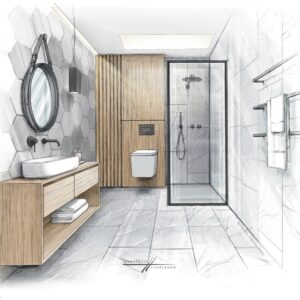 Designing a beautiful bathroom can be tricky and challenging as there are so many factors to consider. But so can installation – in fact a poor installation can ruin a beautiful design and your dream of the perfect bathroom.
Designing a beautiful bathroom can be tricky and challenging as there are so many factors to consider. But so can installation – in fact a poor installation can ruin a beautiful design and your dream of the perfect bathroom.
Many bathroom installers are top noch and you won’t have any problems. They’ll take care of everything and deliver a superb finish that’ll last you a lifetime without problems.
But, then there are those who say they’re the best but turn out to be the worst.
In this article, I’ll uncover the installation tips and tricks of the trade to empower your decision making process, helping to ensure you get the very best from your project.
From tile grout and RCD protection, I’ve got you covered…
So here’s my no-nonsense, expert guide to help you through the maze of considerations.
Having had many years of hands-on experience with the electrical work in all formats of bathroom, from simple fitouts to high-end specs, and working with the guys who do all the plumbing and fitting work, I’ve seen all the ups and downs from both the Client and Installer perspective, and I’ve seen many of the challenges you can face once your installation commences.
1. Inception and choices
Having an idea of what you want is a good starting point. Bathroom design and refurbishment has been a staple of domestic life for the past 100 years or so, so there’s no shortage of both lifestyle magazine and online images to help shape your ideas. But away from the dreams of the ideal bathroom, there’s a certain journey to take in order to make it all become a reality!
staple of domestic life for the past 100 years or so, so there’s no shortage of both lifestyle magazine and online images to help shape your ideas. But away from the dreams of the ideal bathroom, there’s a certain journey to take in order to make it all become a reality!
Planning Steps:
> Gathering design aspirations
> Choosing (not necessarily buying at this stage) furniture, fittings and tile styles (in order to inform the design plans)
> Design (Professional or Self-Design)
> Choosing then engaging an installer/ fitter
> Procuring all of the furniture, fittings and tiles (accounting for potential long lead-times)
> Managing the job (and if this is your only bathroom, arrangements during the job when there may be no access to your usual facilities)
2. Choosing furniture, fittings and tile styles
Choices are vast and plentiful! As this is such a personal choice, all I can recommend is that you find YOUR style in one (or more) of the countless retailers up and down the country.
3. Design
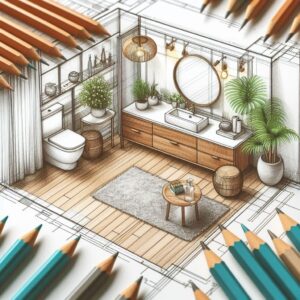 Depending on the size and complexity of your aspiration, you could choose to draw up your own design (based on the fitting dimensions of your choice) or find a bathroom design person to do it for you.
Depending on the size and complexity of your aspiration, you could choose to draw up your own design (based on the fitting dimensions of your choice) or find a bathroom design person to do it for you.
But if you do your own design, you need to be aware of potential constraints such as:
> Existing drainage pipework – if you don’t want the cost and complexity of changing existing drainage routes, then you’ll need to plan your design around these. Otherwise, go wild!
> Existing doorways and windows – again, go wild if you have the choice to change these; otherwise, plan your design around these fixed features.
> Live in a concrete structured flat or apartment? In which case, the concrete walls, floors and ceilings will most likely be non-alterable, so you’ll need to design around such constraints.
Other Design Considerations
Bathroom or Wetroom – whats the difference? A bathroom needs no introduction, but….
What is a Wet Room?
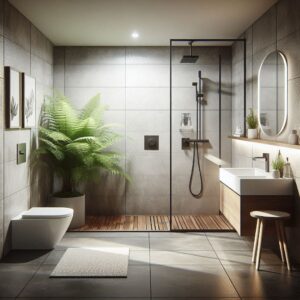 A wet room is a bathroom where there is no shower tray or bathtub, but an open plan floor area that may (or may not) have a simple fixed shower screen. The idea is that the entire (flat) floor area is one with no dividers such as a shower tray.
A wet room is a bathroom where there is no shower tray or bathtub, but an open plan floor area that may (or may not) have a simple fixed shower screen. The idea is that the entire (flat) floor area is one with no dividers such as a shower tray.
These are desireable to some for many reasons, but one is accessibility for disabled persons, inc those needing wheelchair access – the wetroom makes WC and shower access much easier.
Installation TIP – and a very important one! The waterproofing integrity of the sub-floor is a very specialist skill and must only be done by specialists (or highly competent persons) familiar with wet room installations. If the tanking is not done properly, water will start coming through into the room below (or your foundations if its on a ground floor) causing costly damage.
Bathoom Floor Tiles – installation considerations
A common issue on joist supported floors (i.e. the upstairs areas of UK homes) is that floor tiles may start to crack and/ or grout starts breaking off leaving hollow gaps between the tiles.
This happens because the sub-floor flexes ever so slightly when walked on, and over a period of time causes tiles to crack and/or ground to break.
So to avoid this, floors must be supported on an additional layer of 18mm ply board, which is why many bathrooms have a slight 25-30mm step up when you enter.
However, and perhaps obviously, this is not an issue on concrete floors or floors where timber (or laminate) floorboards are to be installed instead of tiles.
In terms of choice – try to choose a non-slippery type. Shiny marble may be your style, but one slip on a wet floor could lead to very serious injury!
Bathoom Wall Tiles – installation considerations
When wall tiles are installed onto stud-partition walls (hollow walls), it’s essential that cement boards are used in place of plasterboards. These are rigid enough to support wall tiles and prevent cracking due to tiny flexing in the wall structure due to human movement.
However, this is not an issue on solid walls – tiles can be installed stright onto such walls.
Bathroom Heating
A consideration for many is whether to install UFH (Under Floor Heating) or rely on electric or central-heating radiators. This largely depends on space, layout and personal preference.
UFH comes in two formats – electric, or water (from your central heating system). Both need to be installed by a competent person prior to the tiles or other finish being installed.
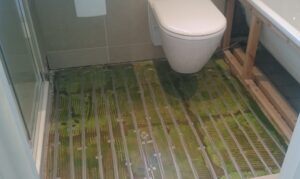 < In terms of electric – I’d like to clear up one point that many people ask me about. Your Floor Tiler is the one who installs the electric floor mat, NOT the electrician. This is because the electric mat gets bonded into the floor grout when the tiles are being laid and that’s not something the electrician would do.
< In terms of electric – I’d like to clear up one point that many people ask me about. Your Floor Tiler is the one who installs the electric floor mat, NOT the electrician. This is because the electric mat gets bonded into the floor grout when the tiles are being laid and that’s not something the electrician would do.
However, the electrician would be presented with both the feed cable and the sensor cable ready to be connected up to the controller on the wall outside the bathroom.
Towel Radiators – whether electric* or water, these are recommended for the main purpose of drying 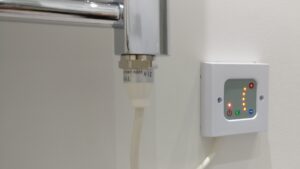 towels. *With electric models, most come with no controllable timer thermostat meaning that the tend to run ‘red hot’ until manually switched off. These increase the risk of burns (especially for children) and very much shortens the life of the unit.
towels. *With electric models, most come with no controllable timer thermostat meaning that the tend to run ‘red hot’ until manually switched off. These increase the risk of burns (especially for children) and very much shortens the life of the unit.
The solution is to ask your electrician to install a stat controller.
Cabinets and Storage
Of course, an important consideration for storing the myriad of small consumable washing items.
Again, the choices are vast and plentiful! And again, as this is such a personal choice, all I can recommend is that you find YOUR style in one (or more) of the countless retailers up and down the country.
If the main mirror/ cabinet requires power, then this needs to be incorporated into the electrical design.
Electrical Considerations
There are many considerations as I’ll talk about here.
Under the UK electrical regulations (BS7671) and Part P (building regulations) the bathroom is condsidered a ‘special location’ where extra rules apply. These rules include ‘Zone’ areas which restrict the types of electrical fitting that can be used.
And of course, any changes to the existing circuits must be signed off by a qualified electrician, AND an electrical certificate must be produced. This is a part of the installation that may need to be outsourced to a qualified spark.
> Lighting
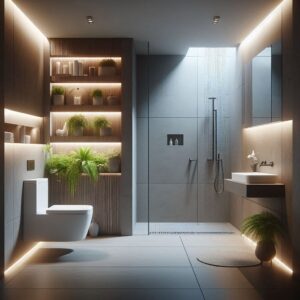 One of the most important electrical features of your bathroom is the lighting. This could be anything from a simple fitting in the centre of the ceiling, to wall lights, downlights and/ or discreet LED strip lighting revealing particular details.
One of the most important electrical features of your bathroom is the lighting. This could be anything from a simple fitting in the centre of the ceiling, to wall lights, downlights and/ or discreet LED strip lighting revealing particular details.
Whatever your choice, any direct mains fitting must be IP65 rated, while any extra-low-voltage (12 or 24volts) lighting drivers must be sited away from water spray and be accessible for future maintenance.
Switches are to be (in most cases) located outside the bathroom door. The alternative is the pull-cord switch but these are not most people’s design choice.
> Extractor fans
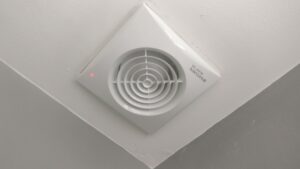 Auto-timer extractor fans are mandatory for internal bathrooms (i.e. ones with no external window) along with an isolator switch outside the bathroom door. But these two items are optional for bathrooms with external windows. However, I’d always recommend installing regardless as not many people want the window open in the middle of winter. IP65 rated is the usual requirement.
Auto-timer extractor fans are mandatory for internal bathrooms (i.e. ones with no external window) along with an isolator switch outside the bathroom door. But these two items are optional for bathrooms with external windows. However, I’d always recommend installing regardless as not many people want the window open in the middle of winter. IP65 rated is the usual requirement.
> Sockets – in the UK (only), mains sockets are not permitted in bathrooms which are considered ‘special areas’ under the electrical regulations.
> Toothbrush sockets/ Powered mirrors
Don’t forget to install an electrical feed if you intend to use either of these items.
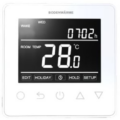 > UFH (electric)
> UFH (electric)
Under floor heating – if this is your design choice, ensure your electrician provides the electrical feed and controller outside the bathroom door. Controllers should be mounted at eye level for ease of access
> Towel Radiators (electric)
If your choice of towel radiator doesn’t have a built in thermostatic controller, it’s important to ask your electrician to install a supplementary one.
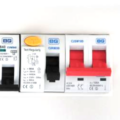 > RCD protected circuits
> RCD protected circuits
All new or modified circuits must be RCD protected for personal safety, and in order to meet the electrical regulations. Ask your electrician to check your installation to verify of one is requried.
4. Finding a Bathroom Fitter
Yes, you need the best bathroom fitter you can find. But to be blunt, the quality of the fitter directly relates to the budget you can afford to pay!
Finding: The best way of finding your ideal fitter would be recommendation/ word of mouth. This could be through a community WhatsApp group, a person known to you, or from a specialist bathroom retailer who recommends preferred suppliers. Then there are the many online trade directories. Through these routes, there is to a degree, a path of accountability (in the form of public reviews) should things turn sour.
Specialist considerations: If your bathroom requires something very specialist (such as a tanked wetroom floor) then you must ensure the person you’re asking has such skills or can outsource to someone with those skills.
Insurance: You may wish to check they have vaild and suitable insurance, as any serious mistake such as faulty pipe connector that busts apart for example could cause massive and costly damage.
Costs: While I’m not up to speed on day-rates around the UK, here in Surrey & Middlesex many top fitters charge around £350 per day for labour and it can take around 10 days to complete an average sized bathroom.
Scope: You need to be really clear as to what services they offer – some installers may do everything, but others may do plumbing and fitting but not tiling for example. If this is the case, you need to either get in other trades yourself, or ask your preferred installer if he/she can outsource parts of the installation to trustworthy others.
Engagment: For more detailed advice on engaging your bathroom fitter, check out my article on choosing a builder »
5. Procurement
It’s vital to pre-purchase all of the furniture and fittings in advance of your bathroom installers as any delays to delivery or changes of mind (on your part) will delay your installers who may in turn charge you for lost labour days.
While some items may be readily available, other items may need to be ordered and may have extended delivery times especially for more unique or exotic furniture and fittings. You may end up buying items from different suppliers. So this needs to be a key factor in your planning.
6. Managing Your Installation
It’s likely that your main installer will manage his/her own project (in line with the labour quote), or the main supplier of the service (if you buy a package from a single supplier).
If you are managing your own installation, then many of the tips given above should help you greatly. But either way, you need to be acutely aware of and actively monitor threats to the budget due to the myriad of ‘unforeseen issues’ that can and do occur.
If this is your only bathroom, you will need to make alternative arrangements during the job when there may be no access to your usual facilities.
Rubbish and Waste – this is something that often gets overlooked. You will have a mountain of stuff to get rid of such as your old bathroom suite, possibly some building rubble and loads of scrap materials and waste. Hiring a skip may be the most cost effective way to handle this matter.
If your skip needs to be parked in the street – you will need a permit from your local council highways team.

